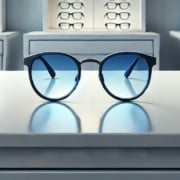Embracing Eye Wellness: The Benefits of Blue Light Filtering Lenses
At Kirman Eye Associates, we understand the challenges that come with prolonged screen time and the importance of protecting your eyes from harmful light exposure. That’s why we offer a range of innovative lens technologies and blue light filtering solutions designed to enhance visual comfort and safeguard your eye health.
Among these, our blue light filtering lenses stand out as a tool in combating the effects of digital eye strain and maintaining overall visual wellness.
At Kirman Eye Associates, we can provide blue light designer glasses tailored to meet your specific needs.
What is Blue Light?

Blue light is a part of the visible light spectrum with a short wavelength, producing a higher amount of energy. While natural blue light from the sun is essential for maintaining a healthy sleep cycle and boosting alertness, excessive artificial blue light exposure can be harmful.
The Impact of Blue Light on Vision
Excessive blue light exposure, particularly from digital screens, can lead to digital eye strain, characterized by symptoms like dry eyes, headaches, and blurred vision. It can also disturb sleep by affecting melatonin production, the hormone that regulates sleep.
Are Blue Light Glasses Effective?
Blue light glasses are designed to block or filter blue light emitted from screens. These glasses have lenses that reduce glare, increase contrast, and make screen time more comfortable. However, studies show mixed results regarding their effectiveness.
For some, blue light filtering glasses may reduce digital eye strain, improve sleep quality, and minimize glare from oncoming headlights during night driving, while others might not notice significant differences. These glasses are not a cure-all solution and should be part of a comprehensive eye health approach, starting with a comprehensive eye examination.
Insights from Kirman Eye Associates
As a leading eye care provider in this southcentral PA community, we emphasize that while blue light glasses can be beneficial for some, they are not essential for everyone. We suggest regular breaks from screens, adjusting screen brightness, and maintaining a healthy distance from devices to alleviate digital eye strain.
Alternatives to Blue Light Glasses
If blue light glasses seem ineffective or unnecessary, there are other ways to protect your eyes from blue light exposure.
- Blue light filtering contact lenses – if you prefer not to wear glasses, but still want to protect from blue light exposure, you may want to consider getting a prescription for Acuvue Oasys Max 1-day soft contact lenses. These daily replacement contacts are the only contact lenses that filter for both blue light and ultraviolet light.
- Screen Settings and Software-Many devices offer settings or software that reduce blue light emission, such as “night mode” or “blue light filter,” adjusting the screen’s color temperature to warmer tones that are easier on the eyes.
- The 20-20-20 Rule-The 20-20-20 rule is an effective strategy to combat digital eye strain: every 20 minutes, take a 20-second break to look at something 20 feet away, helping relax eye muscles and reduce fatigue.
- Proper Lighting-Ensure your workspace is well-lit to minimize screen glare. Position screens to reduce reflections from overhead lighting or windows and consider using an anti-glare screen protector. Our office lenses are tailored for heavy computer use, offering four design ranges to suit different work environments:
- 1-4′ (1 to 4 feet): Best suited for close-up tasks, such as reading or working on a computer screen.
- 1′-7′ (1 to 7 feet): Designed for tasks that require a slightly broader range, such as alternating between a computer screen and nearby objects.
- 1-14′ (1 to 14 feet): Ideal for environments where you need to see both your immediate workspace and objects at mid-range distances, like a shared office space.
- 1-20′ (1 to 20 feet): Suitable for work settings that require viewing both close-up and far away, like in a large office or a meeting room.
The Role of Vision Care
Regular eye check-ups are crucial for maintaining good eye health, especially for those spending a lot of time in front of screens. Eye care professionals can provide personalized advice and recommend corrective lenses if needed. We’d be happy to discuss blue light filter lenses with you.
Blue Light Glasses & Holistic Eye Care
While blue light filtering lenses offer some benefits, they are not a one-size-fits-all solution. Adopting a holistic approach to eye care—regular breaks, adjusting screen settings, proper lighting, and regular eye exams—are essential.
Your eyes are precious and protecting them will pay off in the long run. Be mindful of screen time and prioritize vision health.
Understanding the impact of blue light and taking proactive measures can help you enjoy digital devices without compromising eye health. Stay informed, care for your eyes, and consult a local eye professional to make informed choices about blue light protection.
Key Takeaways:
-
Blue Light Basics: Blue light is high-energy visible light that can affect sleep and contribute to digital eye strain.
-
Potential Impact: Prolonged exposure to blue light from screens may cause eye strain, headaches, and disrupted sleep.
-
Blue Light Solutions: Blue light glasses, filtering contact lenses, screen settings, and the 20-20-20 rule can reduce strain.
-
Holistic Eye Care: Regular eye exams, proper lighting, and tailored lens technologies support overall eye health.







